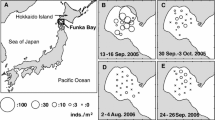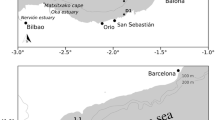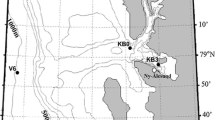Abstract
A large number of northern anchovy larvae, Engraulis mordax, were collected in the Southern California Bight on two CalCOFI cruises during spring 1987, and the amounts of triacylglycerol, cholesterol and polar lipids were measured in each individual larva using the latroscan TLC/FID (thin-layer chromatography/flame ionization detection) system. The 1987 larvae were compared to larvae taken in the Bight during the previous year. Canonical correlation analyses revealed a significant relationship between the larval lipid components and physical/biological data collected at each occupied station during the late 1987 spring cruise, similar to that recorded in 1986. The short-term nutritional condition of the copepod Calanus pacificus was the most important station variable in both cruises. Their triacylglycerol:cholesterol ratio indicated that few of the 1987 larvae had been starving, but their very low contents of length-specific cholesterol and polar lipid indicated that they had been growing very slowly. Otolith readings on defatted larvae confirmed that the 1987 larvae had been growing significantly more slowly than the 1986 larvae. Furthermore, the data suggested that in the 1986 population the faster growing larvae were also those with the highest lipid content. This situation was reversed for the 1987 larvae, when the faster growing larvae in the population seemed to achieve their faster growth only at the expense of a lowered lipid content. The abundance of anchovy larvae was much higher in spring 1987 than in spring 1986 but, despite this, the apparent recruitment (number of Age 0 fish in July of each year) was not higher in 1987.
Similar content being viewed by others
Literature cited
Ackmann, R. G. (1981). Flame ionization detection applied to thinlayer chromatography on coated quartz rods. Meth. Enzym. 72D: 205–252
Ahlstrom, E. H. (1959). Vertical distribution of pelagic fish eggs and larvae off California and Baja California. U.S. Fishery Bull. Fish. Wildl. Serv. 60: 107–146
Arthur, D. K. (1976). Food and feeding of three fishes occurring in the California Current, Sardinops sagax, Engraulis mordax, and Trachurus symmetricus. Fish. Bull. U.S. 74: 517–530
Buckley, L. J. (1984). RNA-DNA ratio: an index of larval fish growth in the sea. Mar. Biol. 80: 291–298
Butler, J. L. (1989). Growth during the larval and juvenile stages of the northern anchovy, Engraulis mordax, in the California Current during 1980–1984. Fish. Bull. U.S. 87: 645–652
Clemmesen, C. M., (1987). A highly sensitive method to determine RNA and DNA contents in individual fish larvae. Int. Counc. Explor. Sea Comm. Meet. (Biol. Oceanogr. Comm.) L 22: 1–14
Coombs, S. H., Håkanson, J. L. (1991). Diel variation in lipid and elemental composition of sprat (Sprattus sprattus) larvae at mixed and stratified sites in the German Bight of the North Sea. Int. Counc. Explor. Sea Comm. Meet. L: 49: 1–11
Frane, J. (1985). Canonical correlation analysis. In: Dixon, W. J. (ed.) BMDP statistical software. University of California Press, Berkeley, p. 500–508
Håkanson, J. L. (1984). The longterm and shortterm feeding condition in field-caught Calanus pacificus, as determined from the lipid content. Limnol. Oceanogr. 29: 794–804
Håkanson, J. L. (1987). The feeding condition of Calanus pacificus and other zooplankton in relation to phytoplankton pigments in the California Current. Limnol. Oceanogr. 32: 881–894
Håkanson, J. L. (1989a). Analysis of lipid components for determining the condition of anchovy larvae, Engraulis mordax. Mar. Biol. 102: 143–151
Håkanson, J. L. (1989b). Condition of larval anchovy (Engraulis mordax) in the Southern California Bight, as measured through lipid analysis. Mar. Biol. 102: 153–159
Hunter, J. R., Goldberg, S. R. (1980). Spawning incidence and batch fecundity in northern anchovy larvae, Engraulis mordax. Fish. Bull. U.S. 77: 641–652
Jacobson, L. D., Lo, N. C. (1991). Spawning biomass of the northern anchovy in 1991. NOAA natn. mar. Fish. Serv. SWFSC admin. Rep. LJ-91-19
Kiørboe, T., Munk, P., Richardson, K., Christensen, V., Paulsen, H. (1988). Plankton dynamics and larval herring growth, drift and survival in a frontal area. Mar. Ecol. Prog. Ser. 44: 205–219
Methot, R. D. (1981). Growth rates and distributions of larval and juvenile northern anchovy, Engraulis mordax, with inferences on larval survival. Ph. D. thesis. University of California, San Diego
Methot, R. D. (1983). Seasonal variation in survival of larval northern anchovy, Engraulis mordax, estimated from the age distribution of juveniles. Fish. Bull. U.S. 4: 741–750
Methot, R. D. (1989). Synthetic measureents of historical abundance and mortality for northern anchovy. Am. Fish. Soc. Symp. 6: 66–82
Methot, R. D., Kramer, D. (1979). Growth of northern anchovy, Engraulis mordax, larvae in the sea. Fish. Bull. U.S. 77: 413–423
O'Connell, C. P. (1976). Histological criteria for diagnosing the starving condition in early post yolk sac larvae of the northern anchovy, Engraulis mordax Girard. J. exp. mar. Biol. Ecol. 25: 285–312
O'Connell, C. P. (1980). Percent of starving northern anchovy (Engraulis mordax) in the sea as estimated by histological methods. Fish. Bull. U.S. 78: 475–489
Parrish, R. H., Nelson, C. D., Bakun, A. (1981). Transport mechanisms and reproductive success of fishes in the California Current. Biol. Oceanogr. 1: 175–203
Peterman, R. M., Bradford, M. J., Lo, N., Methot, R. D. (1988). Contribution of early life stages to interannual variability in recruitment of northern anchovy (Engraulis mordax). Can. J. Fish. aquat. Sciences 45: 8–16
Scripps Institution of Oceanography (1987). Physical, chemical and biological data. California Cooperative Oceanic Fisheries Investigations (CalCOFI) Cruises 8703, 8705, University of California, Scripps Institution of Oceanography, La Jolla (SIO Ref. 87–19)
Stevenson, J. C. (1962). Distribution and survival of herring larvae (Clupea pallasi Valenciennes) in British Columbia waters. J. Fish. Res. Bd Can. 19: 735–809
Theilacker, G. H. (1986). Starvation-induced mortality of young sea-caught jack mackerel, Trachurus symmetricus, determined with histological and morphological methods. Fish. Bull. U.S. 84: 1–17
Author information
Authors and Affiliations
Additional information
Communicated by M. G. Hadfield, Honolulu
Rights and permissions
About this article
Cite this article
Håkanson, J.L. Nutritional condition and growth rate of anchovy larvae (Engraulis mordax) in the California Current: two contrasting years. Marine Biology 115, 309–316 (1993). https://doi.org/10.1007/BF00346349
Received:
Accepted:
Issue Date:
DOI: https://doi.org/10.1007/BF00346349




